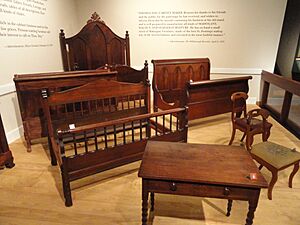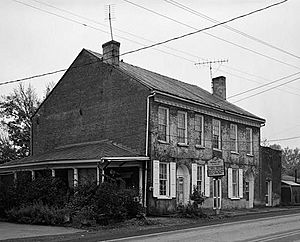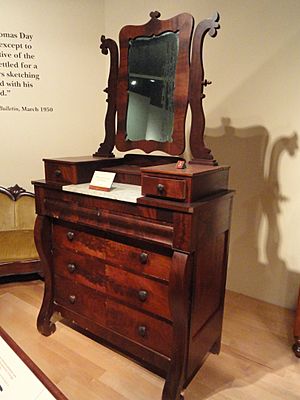Thomas Day (cabinetmaker) facts for kids
Quick facts for kids
Thomas Day
|
|
|---|---|
| Born | 1801 Dinwiddie County, Virginia, U.S.
|
| Died | 1861 (aged 59–60) Milton, North Carolina, U.S.
|
| Occupation | Cabinetmaker, farmer |
| Spouse(s) | Aquilla Wilson (m. 1829) |
Thomas Day (1801–1861) was a famous American furniture maker. He was also a skilled cabinetmaker in Milton, Caswell County, North Carolina. Born into a free Black family in Dinwiddie County, Virginia, Day moved to Milton in 1817. He became a very successful businessman. By the 1850s, his workshop was the largest and busiest in North Carolina.
Day made furniture for wealthy white customers. People respected him for his amazing craftsmanship and hard work. His family was quite well-off, and he received a private education. Today, furniture made by Day is very valuable. It is often displayed in museums like the North Carolina Museum of History. Thomas Day is celebrated as a talented craftsman and smart businessman. He achieved success despite the challenges he faced as a Black man in the Antebellum South.
Contents
Early Life and Family
Thomas Day was born in 1801 in Dinwiddie County, Virginia. His family was free Black. His father, John Day, Sr., was also a cabinetmaker. Thomas learned a lot about making furniture from him. Thomas and his older brother, John Day, Jr., went to private schools. They even boarded with white families and went to school with white children. This gave Thomas a good education, similar to what white children received at the time.
John Day, Sr., often had money problems. This led the family to move to North Carolina in 1817. There, Thomas and his brother started their own furniture shop in Milton. Later, John Day, Jr., left the furniture business. He became a missionary and moved to Liberia. Thomas Day stayed in Milton. He became very successful and respected for his skills.
In 1829, Thomas Day married Aquilla Wilson. She was also a free Black woman from Virginia. However, North Carolina had strict laws about free Black people moving into the state. Aquilla was not allowed to enter. The people of Milton, including important lawmakers, asked the state to make an exception for her. They said Day was so skilled and respected that his wife should be allowed to join him. Because of this support, Aquilla was allowed to move to North Carolina.
Thomas and Aquilla had three children: Mary Ann, Devereux, and Thomas Jr. Their children were educated in the North. The Day family was also important members of the Milton Presbyterian Church. Thomas Day even crafted the church pews. He was highly respected in the community.
Day's success was helped by his white customers and his good education. Laws in North Carolina were somewhat less strict for free Black people compared to other Southern states. Free Black people could gain respect if they were seen as hard workers. Thomas Day also owned some land and slaves, which was unusual for free Black people. This, combined with his mixed race, education, and business skills, helped him succeed. By 1850, Thomas Day owned 14 slaves.
As time went on, tensions between white and free Black people grew. Laws also became stricter. This made it harder for Day's business in the late 1850s, especially after the economic panic of 1857. Still, Day was highly respected in Milton. This was clear from his church status and wealthy customers.
Furniture Business Success
After moving to North Carolina, Thomas Day started his own furniture business. By 1823, his shop in Milton was already well-known. After his brother left, Thomas took full control of the business.
In 1827, Day bought property for his workshop on Milton's main street. He advertised his business in newspapers. Over the next ten years, he bought more land to make his workshop bigger. In 1848, he bought the Union Tavern building. This became his home, workshop, and showroom until he died in 1861. Day ran his workshop for 40 years. He always had furniture for sale and took on special projects for important clients.
The Union Tavern building had Day's family home upstairs. His workshop was in the back, and his showroom was on the ground floor. Day used different types of workers in his shop. He employed white apprentices, free Black workers, and his own slaves. He usually had about 12 to 14 employees. Day also owned a tobacco farm where his slaves worked, which brought him more money.
In his early years, Day used hand tools. But in the 1840s, he added steam power to his workshop. This made his work faster and allowed him to produce more furniture. He could easily make parts using standard designs. This meant he had ready-made pieces when orders came in. Today, experts can often tell which furniture was made around this time. These pieces show a mix of hand-crafting and machine-made parts.
Day's workshop made many kinds of furniture, like armoires and chairs. He also did architectural work for homes. He was known for using veneers and mahogany. He imported mahogany from places like Africa and Central America. Day was very confident in his style. He would even discuss designs with clients to ensure the best quality.
Day's beautiful furniture was noticed by many important people. His business served high-status clients, including the University of North Carolina at Chapel Hill. In 1847, UNC hired Day to create pieces for their student societies. He worked on this project for two years. Even though it cost more and took longer than expected, UNC trusted his skills. In 1855, Day was hired by North Carolina Governor David Reid to furnish his home. Day made 45 complex pieces for this project. In 1856, Day won an award at the NC State Fair for a mahogany wardrobe.
Having such important clients helped Day's business grow. It also gave him influence in Milton and with the state government. This was especially helpful when he needed his wife to enter the state. Day's excellent customer service and skilled craftsmanship made his workshop the best in North Carolina. He contributed a lot to the state's economy.
By 1840, Day's business had $1500 worth of resources. In 1850, it was worth $5800 and held about $8000 in furniture and tools. Day had a high personal credit rating. However, the economic panic of 1857 caused his business to decline. Day declared bankruptcy. After his death, his son, Thomas Day, Jr., bought the workshop back. It continued to run for another ten years, closing in 1871.
Artistry and Design
Thomas Day's success came from his skill in making beautiful furniture. Owning a Day piece showed that a family had wealth and good taste. Day often used popular city styles for his basic designs. Then, he added his own unique touches. He mostly worked with imported mahogany. Sometimes, he put thin layers of mahogany (veneers) over cheaper woods like yellow pine or walnut.
Day's workshop made many types of furniture. These included wardrobes, bureaus, and lounges. He also created wooden architectural details for wealthy homes. All of Day's work was custom-made. He changed each piece to make it unique for every customer. It can be hard for researchers today to identify his early pieces. However, some pieces are easier to spot. Day often used shipping crates with his name on them for the inside parts of his furniture.
Furniture Craftsmanship
Day's furniture style changed over the years. He often took popular urban styles and added his own creative ideas. His designs were usually balanced and symmetrical. Some scholars think his style might show his African heritage. African art often has creative and rhythmic designs. However, other experts say that many rural American furniture designers also added their own touches to popular styles.
Day often used curved shapes in his designs. These curves, like s-shapes, created a sense of movement. He also balanced horizontal and vertical lines. This made his pieces feel harmonious. On some tables, Day carved animal paws, even adding fur details. He also carved designs that looked like tobacco leaves. These touches showed his connection to North Carolina's tobacco farming.
Day's earlier works followed the Grecian Style. This style combined German, French, and English designs. Day's Grecian pieces had detailed moldings. He also used clever tricks, like placing one long glass pane behind several frames to create the look of multiple small panes. He used strong dovetail and mortise-and-tenon joints.
Day was famous for using mahogany veneers. Common designs in his furniture include s-scroll and s-curve shapes. These curves were often used for support, like armrests or legs. They also made large pieces seem lighter. The scroll shape also had a practical use. Some chair armrests were designed so military officers could sit without removing their swords. Day often combined sharp, square edges with curved bottoms. He also used classical elements like columns.
One unique piece of furniture from Day's shop is the "Day Bed" or lounge. He took a common lounge design and made it his own. He used his signature scroll and s-curves. The design featured light pillar supports that turned into scroll curves. The backrest had curvy shapes that created interesting empty spaces. About twelve of these lounges are known to exist today. They were made between 1845 and 1860.
As Day's style grew, he moved towards the Rococo style in the 1850s. He developed his "Exuberant Style." In this style, Day added his favorite motifs to Rococo designs. He used contrasting s-curves and c-curves to create balance and symmetry. This was different from traditional Rococo, which often used asymmetry. His Exuberant Style also included scalloped edges and "thumb" motifs. This style was used in almost all his furniture in the 1850s.
Architectural Craftsmanship
Because his furniture was so popular, Day also started doing architectural work for homes. He used many of the same design ideas as in his furniture. He worked on large plantation homes in North Carolina and Virginia. He made mantle pieces, stair brackets, newel posts, and door frames. His architectural work focused on symmetry. He often matched designs in newel posts and stair brackets. This created a balanced look, especially since many of these homes also had Day's furniture.
Day's door frames often had repeating rectangular patterns. He also made newel posts for staircases. These posts often had s-curves and long scroll shapes. Day's posts were larger and longer than classic Greek Revival posts. He also crafted stair brackets to match his newel posts. These had curves and wave patterns, creating a smooth, flowing look. Matching newel posts and stair brackets seems to have been unique to Day's work. His mantle designs often featured ionic columns with wavy friezes.
Overall, Day's architectural work, like his furniture, focused on creating balanced motion with curves. Unlike his furniture, Day sometimes added carved faces to his architectural work, especially on mantles. Some scholars think these faces might connect to his African heritage. However, most experts believe they are more influenced by Euro-American designs. Day's style is seen as uniquely American. It combines popular designs with local artistic traditions.
Today, seven houses on the National Register of Historic Places have woodwork attributed to Thomas Day. These include Brandon Plantation and Longwood. Fittings in the Presbyterian Church and Baptist Meeting House in the Milton Historic District are also his work.
Legacy and Recognition
Thomas Day is remembered as a skilled craftsman. He put his own style into popular designs, creating unique furniture and architecture. After his death, especially after the Civil War, he was recognized for his hard work and talent. Despite the challenges of his race, his skill and success were highly valued.
Day's Union Tavern workshop was added to the National Register of Historic Places in 1975. Sadly, it burned down in 1989. Since then, there have been efforts to restore the workshop. The Historic Preservation Foundation of North Carolina bought the burned building. They created an organization to rebuild Union Tavern and preserve Day's legacy. Today, Union Tavern is restored. It is a hands-on museum where visitors can touch and examine Day's furniture.
For a long time, there wasn't much scholarly research on Day's work. But in the 1980s and 1990s, researchers began to study his furniture and building techniques. Historians continue to find and document Day's existing work in homes across North Carolina and Virginia.
Day’s work has often been shown in museum exhibits. The first major exhibit was at the North Carolina Museum of History in 1975. It was called “Thomas Day, Cabinetmaker.” The museum was able to buy furniture Day made for Governor Reid thanks to a donation. The museum now has the largest collection of Day's furniture in the world.
In 1994, a DuSable exhibit on African-American craftsmanship featured eleven of Day's works. The Thomas Day Education Project was founded in 1995. It aims to teach people about Day and Black entrepreneurship. They work with the NC Museum of History to train teachers and provide materials. They also made a documentary about Day for public television.
In 1996, the NC Museum of History had another exhibit called “With All Necessary Care and Attention: The Artistry of Thomas Day.” It showed over twenty examples of his work. In 2001, a festival was held in Day's honor in North Carolina. It encouraged Black and minority entrepreneurship. In 2010, a new exhibit, “Behind the Veneer: Thomas Day, Master Cabinetmaker,” opened at the NC Museum of History. It featured 78 pieces of his work.
Most recently, the Renwick Gallery at the Smithsonian American Art Museum in Washington, D.C., had an exhibit on Day. It was based on a 2010 book about him.
All this research and public education has helped Thomas Day become more widely known. The furniture company Craftique sells reproductions of Day's work. Profits from these sales have gone to restore the Union Tavern workshop. Day's furniture is still highly valued by collectors and scholars. Pieces made by Day sell for high prices.
Thomas Day's legacy in North Carolina and in history is strong. People are increasingly interested in his life and work. He is remembered for his skill and service. A statue of him stands outside the NC Museum of History. This places him permanently in mainstream history, both in North Carolina and in the field of craftsmanship.





